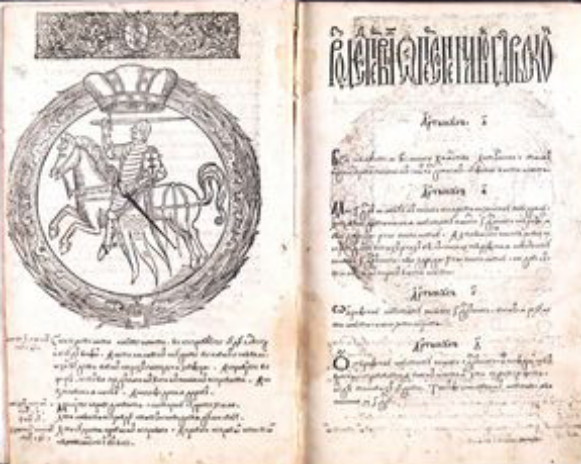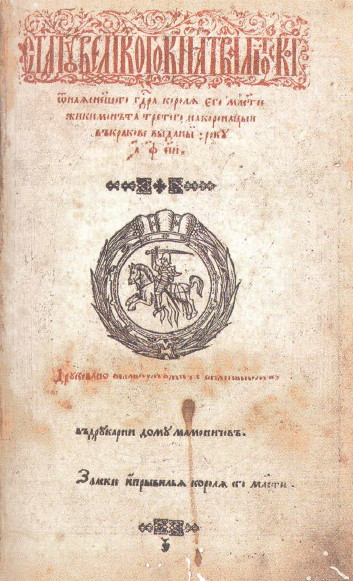Lithuanian-Ruthenian state
Lithuanian-Ruthenian state [Литовсько-Руська держава; Lytovs’ko-Rus’ka derzhava]. A feudal state of the 13th to 16th centuries that included Lithuanian, Belarusian, and Ukrainian territories. Each of its constituent principalities enjoyed a wide-ranging autonomy. The ruler was the grand duke, who was assisted by a boyars' council. From 1323 the capital was Vilnius. The state was shaped by its struggles with the Teutonic Knights, the Principality of Galicia-Volhynia, the Tatars, and then Poland and Muscovy. Lithuania began to encroach on Ukrainian and Belarusian territories during the reign of its founder, Mindaugas (1236–63). Gediminas (1316–41) and his son, Algirdas (1345–77), annexed the Pynsk region, Berestia land and the lans of the Chernihiv principality, Siversk principality, Podilia, Pereiaslav principality, and Kyiv principality. Weakened by Tatar attacks and internal strife, the Ukrainian princes offered little resistance to Lithuanian hegemony and joined its administrative system.
Political and cultural life in the Lithuanian-Ruthenian state was based on the traditions of the Kyivan Rus’ and Galician-Volhynian states. An official Ruthenian language evolved from the language used in Rus’. The legal system was based on the legal traditions of Kyivan Rus’ (see Lithuanian-Ruthenian law and Lithuanian Statute). The Lithuanians also benefited from the military expertise of Rus’ in organizational and fortification skills. Dynastic ties between the princes of Rus’ and Lithuania helped to maintain the Ruthenian influence. The Ruthenian princes belonged to the duke's councils and were part of the ruling class. The Orthodox church was allowed to develop freely, and it played an important role in the country's cultural and educational life. Manufacturing and trade developed rapidly in the cities and towns. The situation changed abruptly after 1385, when Jagiełło (1377–92) concluded the Union of Krevo and assumed the Polish crown.
Jagiełło's pro-Polish policies aroused strong Lithuanian-Ruthenian opposition. The ruling classes resisted the Polonization and the Latinization of political and cultural life. Initially the opposition was headed by Vytautas the Great (1392–1430), who supported the Ukrainian princes and intended to make Lithuania-Ruthenia independent of Poland and to expand it southward and eastward. After being defeated by the Tatars in 1399, however, he had to come to terms with Jagiełło. The Union of Horodlo (1413) gave the nobles of the Lithuanian-Ruthenian state, who were Catholic, equality with the Polish nobility but restricted the participation of Orthodox (mostly Ruthenian) lords in state affairs. A new opposition was headed by Jagiełło's brother, Švitrigaila (1430–5). His pro-Ruthenian policy resulted in a split in the Lithuanian-Ruthenian state: the pro-Polish forces installed Žygimantas (1435–40) as grand duke, and Švitrigaila established his power base in Volhynia, which for a brief period became a separate state. After the death of Žygimantas Casimir IV Jagiellończyk (1440–92) was proclaimed grand duke. He continued his predecessor's pro-Polish centralist policy. To appease the growing opposition of the Ruthenian princes, Olelko Volodymyrovych (the grandson of Algirdas) was appointed ruler in Kyiv. The measure strengthened Ruthenian influence on state policy for a time. After Švitrigaila's death (1452) the Volhynian principality was abolished, and after Semen Olelkovych's death (1470) Casimir installed the Polonized M. Gasztod (Gasztołd) as voivode of Kyiv. The Ruthenian princes responded to the growing Polish influence by organizing a conspiracy under the leadership of Mykhailo Olelkovych. The plot was uncovered in 1481, and many of its participants were executed.
The rise of Polish power prompted many Orthodox Ukrainian and Belarusian princes to look for aid to Muscovy, which had defeated the Tatars and was consolidating its centralist state. Ivan III of Muscovy proclaimed himself the defender of Orthodoxy and heir to the Kyiv dynasty. His action increased tensions and military conflicts between Lithuania and Moscow. By the early 16th century most of the territories of the Chernihiv principality and Siversk principality had been annexed by Muscovy. In 1508 Prince Mykhailo Hlynsky and his brothers led an anti-Lithuanian revolt aimed at separating Ukraine and Belarus from Lithuania and renewing the state of Rus’. Theirs was the last attempt of the Ukrainian princes to oppose Lithuanian and Polish power.
Poland spared no effort to bring Lithuania under its control and to transform the personal union signed at Krevo into a complete fusion of the two states. To that end it exploited the lesser Lithuanian nobility, which was promised equal status with the Polish nobility. The Lithuanian aristocracy, magnates and upper nobility continued to oppose the union, which they saw as signaling the demise of the Lithuanian-Ruthenian state. In spite of strong Lithuanian opposition the union of the two states in the Polish Commonwealth was proclaimed in Lublin (1569) (see Union of Lublin). Lithuania preserved some of its autonomy, but the Ruthenian lands formerly under its control were divided. Except for parts of Podlachia and Polisia the Ukrainian lands fell under Polish rule, and virtually all the Belarusian lands remained under Lithuania. Lithuania's legal status within the Polish-Lithuanian Commonwealth remained unchanged until Poland was partitioned in 1772, 1793, and 1795.
BIBLIOGRAPHY
Lelewel, J. Dzieje Litwy i Rusi aż do unji z Polską w Lublinie, 2nd edn (Poznań 1844)
Antonovich, V. (ed). Gramoty velikikh kniazei litovskikh (1390–1569) (Kyiv 1868)
Antonovich, V. Ocherk istorii Velikogo Kniazhestva Litovskogo do poloviny XV v. (Kyiv 1885)
Dashkevich, N. Zametki po istorii Litovsko-russkogo gosudarstva (Kyiv 1885)
Leontovich, F. Ocherki iz istorii Litovsko-russkogo prava: Obrazovanie territorii Litovskogo gosudarstva (Saint Petersburg 1894)
Maksimeiko, N. Seimy Litovsko-russkogo gosudarstva do Liublinskoi unii 1569 (Kharkiv 1902)
Liubavskii, M. Ocherk istorii Litovsko-russkogo gosudarstva do Liublinskoi unii vkliuchitel’no (Moscow 1910)
Picheta, V. Istoriia Litovskogo gosudarstva do Liublinskoi unii (Vilnius 1921)
Chubatyi, M. ‘Derzhavno-pravne stanovyshche ukraïns’kykh zemel’ lytovs’koï derzhavy pid kinets’ XVI st.,’ ZNTSh, 134–5, 144–5 (Lviv 1924–6)
Kolankowski, L. Dzieje Wielkiego Księstwa Litewskiego za Jagiellonów, 1377–1499, 1 (Warsaw 1930)
Jablonowski, H. Westrussland zwischen Wilna und Moskau (Leiden 1955)
Pashuto, V. Obrazovanie Litovskogo gosudarstva (Moscow 1959)
Lubomyr Wynar
[This article originally appeared in the Encyclopedia of Ukraine, vol. 3 (1993).]
.jpg)

